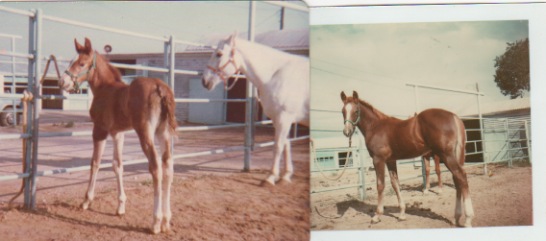First, we can’t safely train any horse not to pull when in dire straits, like something, even another horse running into it.
The blocker ring and such are tools for specific horses and situations and can be used and misused.
The best way to have a horse that stands tied under most circumstances is to be sure horse understands being tied, is taught first to lead and give and stand there and then tied.
We lead mares and just born foals, a few hours old, from the big pen they foal to the stalls with large runs they will stay until after foal heat, then they are turned out.
Mares are very good to handle, foals get a foal halter on, a tail rope and a handler that knows how to use both extremely well and gently, never pulling or letting foal pull.
The timing is in the release, the foal is never held back, mostly followed and gently directed.
We lead mare and foal across the barn yard to the mare stalls and in those, every day we clean stall many times, run twice a day, while cleaning run we halter foal, brush lightly pick feet, use fly spray if necessary, while mare tied to the fence and groomed, than tie foal for the few minutes it takes to clean run and repeat next cleaning time.
That for about three weeks, when mare is hand bred if suitable, then mare and foal turned out to pasture with other mares and foals.
Foals are tied by the mare after they are giving reliably and in a way that if they hit the end of the rope, it slides back and forth.
Fence has several soft pipes, that have some give and rope goes from foal halter over suitable height pipe and is tied to lower pipe.
We never had a foal or later weanling or adult horse hurt that learned this way and they remember all their lives.
Still, if something runs into a tied horse, well, horse will panic and struggle and in that, fight a rope he is tied with, can’t help it.
Foal at almost three weeks old, tied with mare while we clean pen.
This one foal was extremely smart and had learned to pull on the bottom knot and undo it where we wrapped rope below, we had him already tied a bit further than his dam, rope below on the other side of post, so he could not reach it.
It sure made easy weaning time, when they already had some handling manners installed.
This one made a wonderful big strapping colt and was a real gentleman right off once weaned.



 The obvious one being that the majority of cross tie use is about keeping other people and horses safe in environments with many people (and horses) who have a huge range of experience (and training).
The obvious one being that the majority of cross tie use is about keeping other people and horses safe in environments with many people (and horses) who have a huge range of experience (and training). )
) Loose horses were a near daily occurrence there. It drove me nutty.
Loose horses were a near daily occurrence there. It drove me nutty.